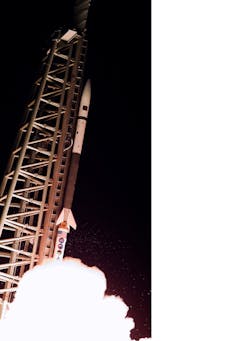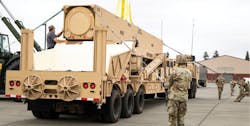By Megan Crouse
Hypersonic missile development continues around the world as militaries jockey to be the fastest threat. Hypersonic — typically considered faster than Mach 5, or 3,836 miles per hour — remains a hotly contested area. Fast enough to offer an adversary only a matter of seconds of reaction time, these are the subject of intense competition and counter-competition, albeit still in early stages. These missiles have the ability to maneuver under their own power on approach, and come in generally two categories: hypersonic glide vehicles, which launch from a rocket and glide from there, or hypersonic cruise missiles, which activate a scramjet after reaching supersonic speeds.
They’ve also kicked off some speculation as to whether American efforts should shift away from large expensive aircraft carriers that would be the weapons’ likely targets. However, some of the projects are themselves intended to fit on vehicles aboard aircraft carriers. The degree to which hypersonic weapons are adopted in the future depends on a variety of technological limitations today.
Regardless of opinion and limitations, industry is mobilizing to make super-fast missiles work. What is being worked on today, and what is coming next? In 2021, the U.S. Department of Defense (DOD) named hypersonic weapons and counter-hypersonic capabilities as the highest technical priorities for the nation’s security, say Raytheon Missiles & Defense personnel involved in one of the DOD projects. The Biden administration requested $7.2 billion for long range fires, including hypersonic missiles, in the 2023 defense budget. According to a 2021 report from the Government Accountability Office, the country’s 70 efforts related to hypersonic weapons are expected to cost nearly $15 billion between 2015 and 2024.
A selection of current projects
Of those 70 efforts, we’ll highlight a few of the more high-profile projects. In the Navy, the Conventional Prompt Strike project is based on the ability to deploy a missile around the world in less than an hour. The Navy is working with the Lockheed Martin Space Systems segment in Littleton, Colo. on a $22.8 million contract to integrate hypersonic weapons on board three stealthy Zumwalt-class (DDG 1000) destroyers.
As well as wanting to have the infrastructure in place for weapons that can handle high-value or fleeting targets quickly, the project also has as a stated goal to “increase today’s industrial base capability for Navy and Army long-range hypersonic weapons [and] build ready-to-fire hypersonic weapons with diameters larger than 30 inches.” Integrating the weapons system with the ships will require building an advanced payload module with weapons in a three-pack configuration, interfaces between the ship and the weapons, support structure, protection, compressed-air ejectors and environmental control. This follows up on a sources-sought notice from 2021.
The Conventional Prompt Strike project shares a hypersonic glide vehicle with the Army’s Long-Range Hypersonic Weapon project, while the Air Force is working on the AGM-183 Air-Launched Rapid Response Weapon (ARRW) and the Hypersonic Attack Cruise Missile.
At the same time, Raytheon Missiles & Defense, Northrop Grumman Corporation, the U.S. Air Force and DARPA continue to work together on the scramjet-powered Hypersonic Air-breathing Weapon Concept (HAWC). Raytheon declared the first test flight a “history-making moment,” with the missile dropping from the wing of an aircraft before activating a solid rocket motor and then the scramjet to push it to hypersonic speeds.
“Decades of learning advanced manufacturing techniques and industry partnerships helped us define what is now possible,” said Dan Olson, vice president and general manager of the Weapon Systems Division for Northrop Grumman, in a press release.
The ARRW project has missed a few deadlines so far. It was supposed to reach early operational capability in October 2021, according to CNN. Instead, it was postponed for up to a year due to “recent flight test anomalies,” said an official Air Force statement.
At the same time, the U.S. is working on anti-hypersonic missile defenses such as the U.S. Next-Generation Interceptor (NGI) and others. The NGI’s goal is to defend against high-speed, precision-guided intercontinental ballistic missiles (ICBMs) and hypersonic missiles in space, as well as to destroy several ICBMs at once. That, in turn, requires electronics sophisticated enough to determine threats from decoys, or to track multiple threats. The DOD has invested in a variety of proposed defenses, all still in progress.
Another forward-looking effort is the U.S. Air Force’s Mayhem project. While details are under strict lock and key, public information states that it seeks developers for a large air-breathing missile with a standard payload interface.
We do know it focuses on extendable multi-mission intelligence, surveillance, and reconnaissance (ISR) and strike capabilities. Proposals were due by May 24.
“We don’t expect hypersonic standardized payload interfaces to be substantially different from those that have come before, except for the addition of the hypersonic-unique environments, such as thermal loading,” says Michael Gay, Engineering Fellow, Raytheon Missiles & Defense. “A key element of such interfaces would be implementation of Open System Architecture elements to ensure that the interfaces are well defined and extensible as both platform and payload capabilities evolve.”
An important distinction in this field is that the U.S. is not focusing on designing hypersonic missiles to be used with a nuclear warhead, although Russia and China potentially could arm theirs with such, notes a 2022 Congressional Research Service report.
Technical limitations around extreme heat
Engineering and manufacturing for hypersonic vehicles is still a relatively new niche. Randy Brodsky of Primus Aerospace in Lakewood, Colo., notes in a blog post that hypersonic vehicle manufacturing only has kicked into high gear in 2018, and still faces some infrastructure challenges. On the other hand, ground work has been laid by efforts like the Conventional Prompt Global Strike (CPGS) program in the early 2000s.
Development in this area is challenging because of the ultra-high-precision and complex machining required for manufacturing, Brodsky wrote. Linear, positional and circular dimensions require tolerances in the thousandths and millionths of an inch for many hypersonic components.
“At hypersonic speeds, friction and air resistance create an incredible amount of heat, which needs to be managed through tough but lightweight heat shields and thermal protection systems,” wrote Scott Greene, executive vice president of Lockheed Martin Missiles and Fire Control, and Richard F. Ambrose, executive vice president of Lockheed Martin Space, in a blog post. “Instruments, like sensors and electronics, must also be equipped and protected to stand up to these extreme conditions.”
Exotic materials often are required for the heat and other performance conditions experienced at hypersonic speeds, leading the military to seek new supply chains for component makers, such as carbon composite producers. Overall, supply chains still need to be solidified in this area, according to the 2020 Institute for Defense and Government Advancement white paper Hypersonic Weapons: Technical Challenges and Emerging Opportunities.
“Managing extreme heat and speed requires inventing and deploying new solutions, advanced materials and composites that can withstand extreme environments,” Greene and Ambrose say.
When it comes to electronics in hypersonic missiles, the vehicle faces the most extreme heat at the leading edge in the final descent. The military and contractors have been trying to solve the problem of cooling this area for decades. Common ways to solve this problem include conduction cooling and heat pipes, often at the same time. Naturally, it’s a little more complicated than installing a fan in a home computer. This is true whether you’re working with a missile or a passenger plane.
“In hypersonic flight the challenge comes from both directions: thermal protection systems are implemented to limit the high surface temperatures of the airframe structure from entering into the cabin space, and passive thermal management schemes to capture the self-generated heat produced by the electronics,” Gay says.
At Mach 6, that temperature can reach up to 1,200 degrees Fahrenheit. “The two sources of heat results in a challenging equation to keep electronic systems operating within their capabilities,” says Gay.
Studying flight turbulence
This March, NASA launched a hypersonic stress test that has been more than a decade in the making. The Air Force’s Office of Scientific Research (AFOSR) Boundary Layer Transition and Turbulence (BOLT II) was the successor to a 2008 project which never got off the ground. However, the March 2022 flight provided important new information about the behavior of a hypersonic vehicle at the ‘boundary layer transition location,’ a state observable in the study of fluid dynamics. Most of the heating on the vehicle will concentrate here. Put simply, this layer also marks the path where airflow changes from calm and laminar to turbulent.
“When turbulent, more of the frictional energy of the particles gets pulled down to the vehicle surface. This added energy to the wall can lead to excessive surface heating that make or break a vehicle design,” says Scott Berry, NASA principal investigator for the roughness experiment for BOLT II, in a NASA news announcement.
“The desire is to be able to tailor the boundary layer to be laminar everywhere, but turbulent just ahead of the engine as flow separations within an engine are likely and more catastrophic if laminar,” says Berry.
The challenges of sensor design
What about sensors, navigation and guidance for hypersonic flight specifically? Gay expressed interest in new approaches to electrical power generation whichSpecifically, he says, people are working on how to “capture the by-products of hypersonic flight in order to provide the power needs of an electrical system.”
“Missiles have multiple consumers of on-board power, and these needs are only increasing over time,” Gay says. “A simple analogy would be an electric vehicle: a basic factor in how far one can drive is the amount of energy stored in the batteries before you start. Regenerative braking is a method to capture a by-product of driving to create energy that can extend the range. In hypersonics people are starting to consider how the high heat generated by flight can be used as a power source to augment or even replace conventional batteries.”
Some of the basic subsystems likely always will be the same as those on a ballistic missile, although the propulsion is very different. The subsystems that need to be integrated include:
a power source;
a computer;
sensors (including ones which can operate independently of ground stations for the reasons listed elsewhere);
actuators such as aerodynamic control surfaces or small cold gas thrusters; and
elements for affixing components, such as cables, bolts, screws, and nuts.
Early experiments in this area were so packed with the components they needed to work that there was no room for a payload, according to a report from the Stockholm International Peace Research Institute.
Communications also can be difficult at hypersonic speeds. Sensor systems need to be built for high-stress environments, while communications channels need global coverage. Telemetry dropout is a concern, as is the severe shock, vibration and temperatures expected at such a high speed and altitude. Of course the United States, Russia, and China have decades of experience in protecting electronics from conditions like these because of their space programs, as well as military rocketry.
But for communications in particular, ground-based stations often aren’t able to see hypersonic weapons at the speed at which they move. Those stations will need to be able no only to warn of incoming missiles, but to keep up with commanding missiles already under way, adjusting them, if needed, in a matter of seconds.
PNT: To GPS or not to GPS?
Position, navigation, and timing (PNT) systems for hypersonic vehicle must be able to live up to all that pressure, too. According to Janes, a 2021 presolicitation request for solutions from the Navy expressed interest in a non-GPS product for this use case. Rather than a response to the technology itself, the Navy sought this in response to adversary tactics that might be capable of jamming or physically compromising GPS systems, in particular GPS-based satellite communication (SATCOM) and assured position, navigation, and timing.
Relatedly, the Charles Stark Draper Laboratory Inc. in Cambridge, Mass., showed off new techniques to ruggedize electro-optical components for PNT in extreme conditions. While not specifically for hypersonic vehicles, the solution is also noted as being applicable where GPS satellites are not.
For example, they might be able to build interferometric fiber-optic gyroscopes and other electro-optical devices to support applications in harsh environments using new manufacturing methods. Draper’s silicon optical benches, which are wafer-level platforms composed of precision-etched surface features, allows for fewer steps in the manufacturing process. In this method, they can assemble several microscale optical components closely together in one device.
Updates for 2022
Last year, we heard about some predictions for major changes coming in the future. These included challenges in testing in international airspace, data security and the perpetually important field of rugged or ruggedized sensors. The DOD’s Office of Inspector General completed a review of the country’s ground test and evaluation facilities in February 2022, but did not release the results to the public, according to the Congressional Research Service. However, this does show the DOD is as aware of this aspect as engineers are, and are actively examining possibilities for testing in relatively realistic conditions without causing an international incident.
In terms of rugged components and ruggedization, shielding is another focus for Gay.“There has been much work associated with assessing and implementing high-temperature materials for use in hypersonic flight,” he says. “However when it comes to electronics there has been much success in the opposite direction, meaning implementing thermal protection and mechanical isolation schemes that shield electronics from the harsh environments created by hypersonic flight, allowing electronic systems to operate within their capabilities.”
Put in simple terms, it’s like packing a glass statue in bubble wrap and paper before trying to ship it. Protecting electronics from heat instead of leaving them out in the elements may seem like standard procedure for any aerospace project.
However, Gay says, “the analysis tools, modelling of environments to create predictions, and ground testing to anchor the models have been new engineering developments.”
Data security
In regards to the increasingly important realm of data and cyber security, hypersonic missile component suppliers are subject to the Cybersecurity Maturity Model Certification (CMMC) framework. Following up on this brings us to a larger shift within how the U.S. government is looking at and managing cyber security. It’s becoming more and more of a priority in any piece of hardware that needs to connect to a network. In this case, the CMMC will now be overseen by the Department of Defense’s chief information officer, not the undersecretary of defense for acquisition and sustainment. With concerns about hacking rising in the international community, the switch seeks to better streamline the process by which CMMC facilitates the creation of new standards and controls for defense contractors. In particular, CMMC was created to prevent threat actors from being able to exploit contractor information.
“By establishing a more collaborative relationship with industry, these updates will support businesses in adopting the practices they need to thwart cyber threats while minimizing barriers to compliance with DOD requirements,” says Jesse Salazar, Deputy Assistant Secretary of Defense for Industrial Policy, in a DOD press release in November 2021.
After all, both digital and physical speed are hot topics in the industry in 2022.
Hypersonic missiles conjure up images of global war. They’re part of the rapidly-changing network of defense technology today, a field which has had to respond to changing capabilities (speed, power) developments in cyber warfare, and the shifting needs of military customers. From the long history of the intercontinental arms race to possible technology crossover with the futuristic-sounding possibility of commercial hypersonic flight, they’re a niche but remarkable part of the industry.



